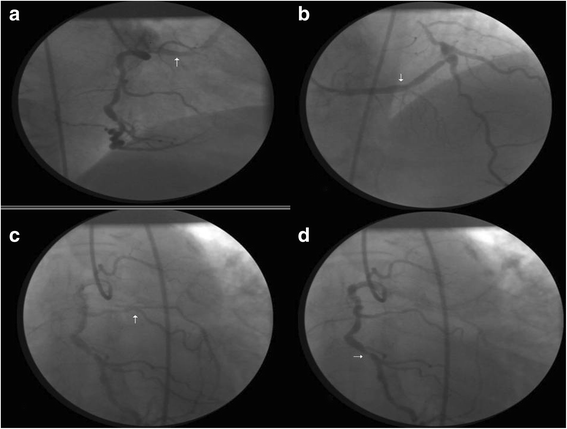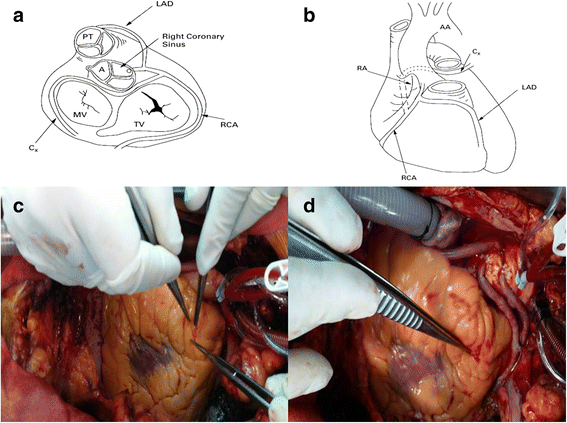A rare coronary anomaly consisting of a single right coronary ostium in an adult undergoing surgical coronary revascularization: a case report and review of the literature
- PMID: 27370010
- PMCID: PMC4930572
- DOI: 10.1186/s13256-016-0977-5
A rare coronary anomaly consisting of a single right coronary ostium in an adult undergoing surgical coronary revascularization: a case report and review of the literature
Abstract
Background: Coronary arteries originating from the right coronary ostium in the ascending aorta represent a very rare anatomic presentation. Also, the presence of a single coronary ostium is an extremely rare finding.
Case presentation: We present the case of a 74-year-old Albanian man from Kosovo. He had unstable angina due to critical triple vessel disease and a single coronary artery originating from a single ostium in the right sinus of Valsalva with an anomalous course of his left anterior descending artery anteriorly to the right ventricular outflow tract as a "T-vessel" from which originated the proximal and distal left anterior descending artery, the circumflex artery originating from the mid portion of the right coronary artery which had a normal course. He underwent successful coronary revascularization consisting of three vein grafts to the right coronary artery, first diagonal and obtuse marginal artery, and left internal mammary artery anastomosed to left anterior descending artery.
Conclusions: We describe a proposed IID1 pattern. After a careful revision of the literature, only six cases have been reported with a similar anomalous coronary origin. Only two out of six patients underwent surgical coronary revascularization. In our case the aberrant vessel arising from his right coronary artery coursed anteriorly to the right ventricle and continued as a left anterior descending artery at its mid portion which then continued distally as the distal left anterior descending artery and proximally as a proximal left anterior descending artery, having the shape of a "T vessel". The "T-vessel" configuration has never been reported in the literature. The reported case with its specific presentation adds further information on this rare form of anomalous origin of the coronary arteries, representing a first report of a configuration that we name the "T-vessel" of the left anterior descending artery. Diagnosis of the coronary anatomy is very important for the invasive cardiologist and cardiac surgeon in cases with a single coronary ostium, such as our case, so that they can proceed with the invasive or surgical treatment when critical coronary artery disease is present.
Keywords: Anomalous origin of the coronary arteries; Case report; Single coronary ostium; T-coronary vessel.
Figures


Similar articles
-
[A case report of bypass grafting for coronary atherosclerosis with anomalous origin of the left coronary artery from the right coronary artery ostium-anterior subtype].Nihon Kyobu Geka Gakkai Zasshi. 1996 May;44(5):702-4. Nihon Kyobu Geka Gakkai Zasshi. 1996. PMID: 8965005 Japanese.
-
Anomalous origin of the left coronary artery from the right sinus of Valsalva in a 62-year-old woman with unstable angina pectoris: a case report.Int J Cardiol. 2010 Jul 23;142(3):e35-7. doi: 10.1016/j.ijcard.2008.11.182. Epub 2009 Jan 13. Int J Cardiol. 2010. PMID: 19144422
-
Anomalous right coronary artery originating from the left anterior descending artery: case report and review of the literature.Int J Cardiol. 2009 Nov 12;137(3):195-8. doi: 10.1016/j.ijcard.2009.03.140. Epub 2009 May 8. Int J Cardiol. 2009. PMID: 19427707 Review.
-
Origin of all major coronary arteries from left sinus of Valsalva as a common coronary trunk: single coronary artery--a case report.Angiology. 2004 Jan-Feb;55(1):103-5. doi: 10.1177/000331970405500116. Angiology. 2004. PMID: 14759098
-
[Single left coronary artery with a fistula to the right ventricle: report of a case with successful closure].Kyobu Geka. 1989 Apr;42(4):325-9. Kyobu Geka. 1989. PMID: 2671456 Review. Japanese.
Cited by
-
Aberrant origin of the left coronary artery from the right coronary sinus with a common orifice with the right coronary artery.Clin Case Rep. 2024 Aug 27;12(9):e9363. doi: 10.1002/ccr3.9363. eCollection 2024 Sep. Clin Case Rep. 2024. PMID: 39206070 Free PMC article.
-
Anomalous coronary artery anatomy with a single coronary ostium arising from the right coronary: a case report and literature review.Int Med Case Rep J. 2019 May 3;12:135-141. doi: 10.2147/IMCRJ.S194029. eCollection 2019. Int Med Case Rep J. 2019. PMID: 31118833 Free PMC article.
-
Successful Management of Anomalous Lipton R-III Right Coronary Artery Chronic Total Occlusion.Cureus. 2024 Jun 1;16(6):e61505. doi: 10.7759/cureus.61505. eCollection 2024 Jun. Cureus. 2024. PMID: 38827417 Free PMC article.
-
An Extremely Rare Case of Anomalous Left Main Coronary Artery Originating From Single Right Coronary Ostium Managed Using Heart Team Approach.Cureus. 2020 Jun 28;12(6):e8879. doi: 10.7759/cureus.8879. Cureus. 2020. PMID: 32617251 Free PMC article.
References
-
- Desmet W, Vanhaecke J, Vrolix M, Van de Werf F, Piessens J, Willems J, de Geest H. Isolated single coronary artery: a review of 50,000 consecutive coronary angiographies. Eur Heart J. 1992;13(12):1637–40. - PubMed
-
- Van Campen LCMC, de Cock C, Bronzwaer JGF, van Rossum AC. Single coronary artery: morphological and functional evaluation by magnetic resonance imaging. Eur Heart J. 1995;16(12):2003–4. - PubMed
-
- Sayar N, Terzi S, Akbulut T, Bilsel T, Ergelen M, Orhan L, Cakmak N, Yesilcimen K. Single coronary artery with subsequent coursing of right coronary artery between aorta and pulmonary artery: fractional flow reserve of the anomalous artery guiding the treatment. Int Heart J. 2005;46(2):317–22. - PubMed
Publication types
MeSH terms
LinkOut - more resources
Full Text Sources
Other Literature Sources

